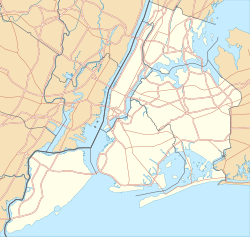Rainey Memorial Gates | |
 | |
| Location | Bronx Zoo, Bronx, New York |
|---|---|
| Coordinates | 40°51′18″N73°52′40″W / 40.85500°N 73.87778°W |
| Area | less than one acre |
| Built | 1934 |
| Architect | Manship, Paul |
| Architectural style | Art Deco |
| NRHP reference No. | 72000823 [1] |
| NYCL No. | 0108 |
| Significant dates | |
| Added to NRHP | March 16, 1972 |
| Designated NYCL | January 11, 1967 |
Rainey Memorial Gates is a historic entrance gate located at the north side of the Bronx Zoo, within Bronx Park in the Bronx, New York City.
Contents
It is a New York City designated landmark and was listed on the National Register of Historic Places in 1972. [1] [2] [3]



